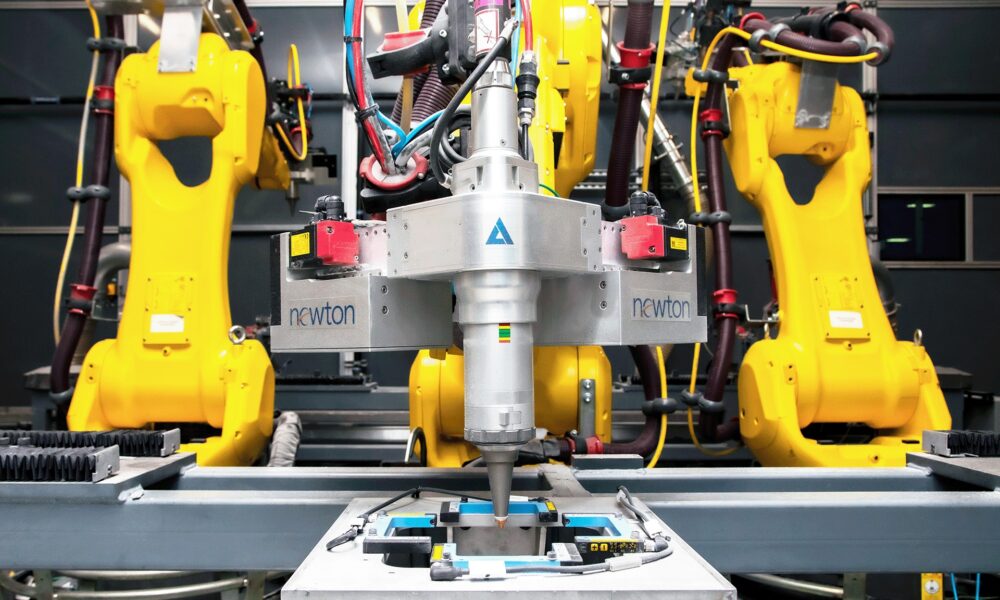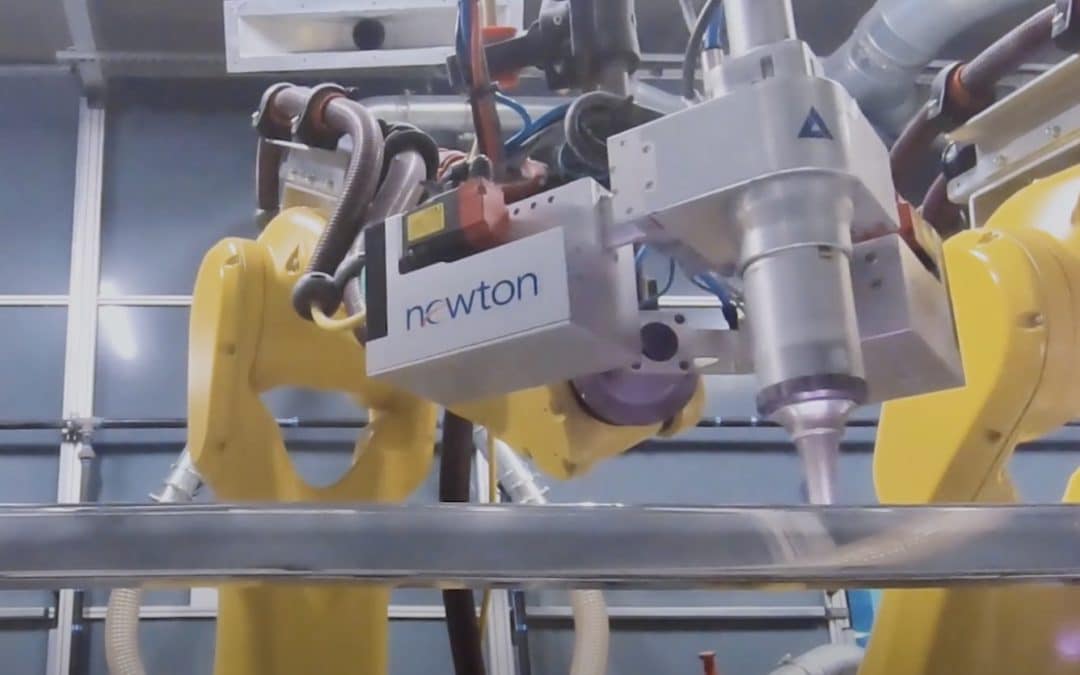A Tier 1 automotive supplier asked Shape Process Automation to respond to an RFQ, they didn’t get what they asked for. Instead, they got a breakthrough proposal that saved the supplier 50% of the total program cost over the five-year project cycle.

There is a saying that goes “When someone asks for a lightbulb, what they really want is light.” The saying points out that when buyers narrow their focus and request a specific thing, they often miss opportunities for unexpectedly better solutions to fulfill their needs.
As an example, a Tier 1 automotive aluminum anodized extrusion supplier recently requested a quote from Shape Process Automation (SPA) to provide a solution in a new facility producing structural aluminum parts. The customer’s initial request was standard islands of automation and after the team at SPA used their ROI automation tools to explore cost models, the result was very different.
Instead, SPA provided a very diverse, alternate solution that achieved a far more cost-effective approach to producing the parts. This solution, a fully automated multi-robot laser cutting cell, created a 50% total cost savings for that portion of the program over the planned 5-year project cycle.
Significant cost reductions
How did this alternate solution generate such an impressive cost reduction?
- A big slice of the savings came from direct labor. Far fewer operators were required for the two cells compared to the originally planned nine.
- The two cells required fewer maintenance and programming people, as well as fewer people to load/unload and transport product around the facility.
- Maintaining equipment and controlling tolerances on just two cells requires less attention from the Maintenance and Quality staff.
- Proprietary software and hardware tools that allow the plants to keep their laser cells running at high OEE. These tools include laser processing intuitive programming software, automated robot / laser head calibration, and daily feature adjustment by the HMI. These tools are designed to minimize the downtime associated with operating the machine, in return the system runs at very high efficiencies.
In all, the originally planned facility staff of approximately 100 people was reduced to fewer than 20. But this shouldn’t be looked as a headcount-reduction effort. For this supplier, they could not forecast where they could find the people and this solution ended up reducing costs which enabled the company to earn business it otherwise would have lost to a competitor.
Beyond these direct-cost reductions, there are other benefits.
- Changeovers on the two robotic lasers between the 18-part numbers/assemblies are a mere two minutes.
- The two cells require about 30% of the floor space compared to the initial approach, reducing both initial capital costs and ongoing operational expenses.
- Quality is more consistent because there are fewer part holding fixtures. In return, less part paths, less maintenance, and lower tolerance variations.
- The robotic laser cutting cells included vision inspection that instantly identify OK or Not-OK parts, enabling rapid process correction.
- When production problems surface, the simple process stream supports expedited traceability, enabling rapid isolation and correction of problem.
- The incoming racks were not automation friendly, like most extrusion companies, so SPA developed a robotic pick solution to handle 18 variations of band and bundled part stacks.
- The amount of dunnage/ inventory space and WIP (work in process) needed was much smaller.
- The number of quality department tasks and cost associated with customer quality demands is reduced due to the number of reduced geometries and weekly CMM reports.
The aluminum extrusion supplier achieved all these savings and benefits – and earned the distinction of having one of the highest-throughput aluminum cutting cells in the industry – by relying on traditional robotic laser-cutting technology combined with a proprietary enhancement provided by SPA that vastly improves both speed and accuracy.
New demands, new solutions
Auto manufacturers, particularly those producing electric vehicles (EVs), have an intense interest in lightweighting their vehicles. That’s driven exploration of both new materials, mainly aluminum and plastics, as well as opportunities to reduce part count. In one striking example from an EV manufacturer’s high pressure die cast aluminum giga castings, the total part count for the engine cradle and rear carriage of a vehicle was reduced from nearly 200 parts to just two.
Ultra-high strength steel hot stamped door rings have been reducing part counts for the last decade and now seeing automotive lift gates transition from 12-18 parts down to 2 parts using composites and /or high pressure die cast aluminum molding technologies. All of these thermal processes require 3-dimensional flexible cutting and daily adjustment as the parts are forever changing sub millimeter tolerances as the day and week evolves.
Working with new materials and incorporating more features in a smaller number of parts necessitated new and sometimes non-traditional production processes. SPA has been at the forefront of developing these processes, many of which rely on laser cutting.
Early CNC lasers provided high accuracy, repeatability and quality, but with relatively low throughput due to single processing head capability. In the past, integrating robotics with the laser tools improved cycle times, but not to the extent required. The previous robots lacked the accuracy needed, being unable to successfully cut features with customer specified 0.1-0.05 mm tolerances.
SPA’s solution is a 3-axis laser positioner called NEWTON® added to a 6-axis robotic arm. The robot provides the “repeatable” location of the laser on the part. Once in the desired location, the NEWTON® positioning device provides the fine motion (path accuracy of ±0.05 mm) of the laser as it cuts the shape required. NEWTON® works at far higher speeds and accuracy than previously possible via direct robot articulation of the laser.
This application involves aluminum extrusion, however NEWTON® is material-agnostic, able to perform equally well on other metals including press-hardened steels, hydroformed materials, High Pressure Die Cast Aluminum, even nonmetal materials as plastic and composite parts can benefit from this technology.
Cycle-time reduction compared to a typical 6-axis articulated cutting robot is nearly 70 percent when executing high tolerance features. The typical solution is to place 4-8 of these NEWTON® robotic cutting heads around a part or In-Line, this allows the customer to increase their plant profit by calculating part throughput per floorspace.
Consider a new cost model
To achieve the kinds of benefits described above, OEM & Tier suppliers would benefit to consider a new cost model when working with their process-equipment suppliers. Most suppliers focus first, and sometimes solely, on capital costs. Had the supplier in this case study followed that approach, they would have instantly rejected SPA’s solution because of the 25% higher capital cost. But capital is only one piece of the total cost puzzle when considering total program costs.
In some, perhaps most, cases, the generic purchasing RFQ model focused on the lowest price is appropriate. But OEM & Tier suppliers that are trying to resolve process/product issues with new thermal process in the effort to lightweight, or are interested in breakthrough solutions to their needs, should work with their trusted suppliers to develop solutions rather than capital costs.
New technology, new opportunities
The aluminum extrusion supplier described above would, just a few years ago, been unable to achieve these remarkable results because the needed technology for large-assembly laser cutting cells didn’t yet exist. Today, thanks to Shape Process Automation’s know-how, technology and experience, they are one of the many Tier suppliers that are streamlining and accelerating the production processes, and earning new business as a result. SPA is driving innovation within the automotive industry with exclusive automation innovations like NEWTON®.


Recent Comments